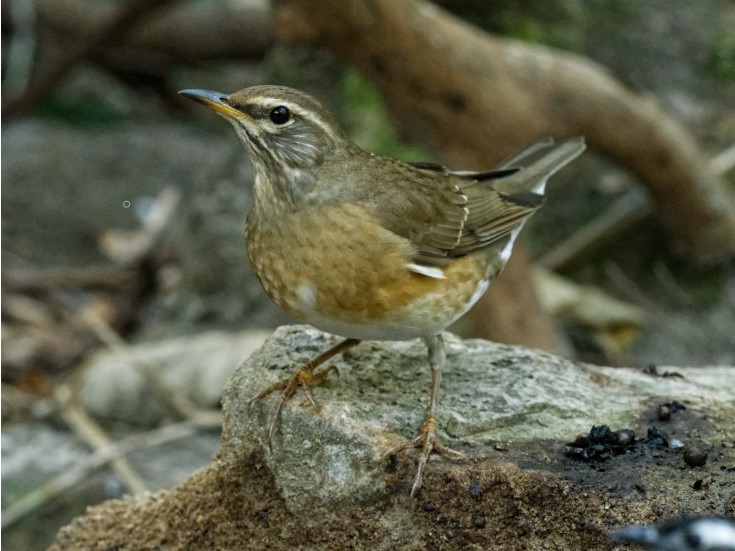Eyebrowed Thrush Turdus obscurus 白眉鶇
Category I. Uncommon passage migrant and scarce winter visitor to forests or lightly-wooded areas.
IDENTIFICATION

Nov. 2019, Guy Miller. Adult male.
Adult males have plain grey head and throat with white supercilium and area below eye, blackish lores, brown upperparts, orange flanks and lower chest and plain greater coverts.

Dec. 2019, Guy Miller. First-year male.
First-year males have obvious buffish-white tips to greater coverts, greyish-tinged head, a marked whitish supercilium and area below eye, blackish lores and, usually, obviously orange flanks and chest.

Nov. 2019, Guy Miller. First-year female.
First-year females are dull and have no grey tinge to head, streaked throat, distinct pale tips to greater coverts and dull orange chest and flanks.
VOCALISATIONS
The typical call is thinner, more buzzing and slightly lower-pitched than Japanese and Grey-backed Thrushes; in addition, when heard well a slight fall in pitch is audible.
DISTRIBUTION & HABITAT PREFERENCE
Eyebrowed Thrushes occur in widespread locations, with winter birds largely in forested habitat while migrants are also present in more lightly-wooded areas.
OCCURRENCE
Whereas most of the regularly-occurring Turdus thrushes are primarily winter visitors, Eyebrowed Thrush is most frequently recorded as a passage migrant (Figure 1). Main autumn passage occurs in November and the first week of December, with the highest count being 132 flying over KFBG on 26 November 2000.
The winter population is present from around the middle of December to possibly as late as the final week of March, during which time it is generally scarce. Spring passage appears to commence at the end of March or early April, mainly occurring from the second week of April to the first week of May. Numbers are rather variable, with the highest counts since 1999 being 260 on 14 April 2016; in addition, 170 were at Tai Lam CP on 3 May 2019, with 165 the following day that no doubt included different individuals. By far the highest count, however, is of at least 1,000 at Tai Po Kau on 16 April 1983. Extreme dates of occurrence are 13 October 1993 and 20 May 2017.
Eyebrowed Thrush was first recorded on 19 April 1941 (Herklots 1953) and was regarded by Herklots (1967) as an uncommon passage migrant, with most records in the final ten days of April.
BEHAVIOUR, FORAGING & DIET
Occurs in flocks during migration periods. Generally seen feeding on fruiting trees and much less in leaf litter on the woodland floor. Has been recorded consuming the fruit of Mallotus paniculatus, Psychotria serpens, Ilex rotunda and Machilus thunbergi.
RANGE & SYSTEMATICS
Monotypic. Breeds central and east Siberia as far south as northern Mongolia and east to northern Sakhalin; winters south China, north Indochina, southeast Asia, Sumatra and Java (Collar 2020). In China breeds in far northeast and winters in southern coastal provinces and Yunnan (Liu and Chen 2020).
CONSERVATION STATUS
IUCN: Least Concern. Population trend unknown.
Figure 1.

Collar, N. (2020). Eyebrowed Thrush (Turdus obscurus), version 1.0. In Birds of the World (J. del Hoyo, A. Elliott, J. Sargatal, D. A. Christie, and E. de Juana, Editors). Cornell Lab of Ornithology, Ithaca, NY, USA. https://doi.org/10.2173/bow.eyethr.01
Herklots, G. A. C. (1953). Hong Kong Birds. South China Morning Post, Hong Kong.
Herklots, G. A. C. (1967). Hong Kong Birds (2nd ed.). South China Morning Post, Hong Kong.
Liu, Y. and Y. H. Chen (eds) (2020). The CNG Field Guide to the Birds of China (in Chinese). Hunan Science and Technology Publication House, Changsha.

